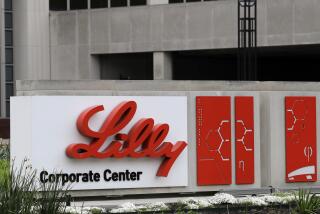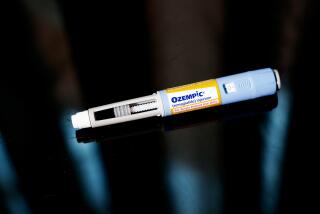Here’s why drug prices rise even when there’s plenty of competition
- Share via
At least eight pharmaceutical companies sell a decades-old drug that treats gallstones, but the competition has done little to keep its price down.
Instead the price has skyrocketed.
Two years ago, ursodiol’s wholesale price was as low as 45 cents a capsule. Then in May 2014, generic drug manufacturer Lannett Co. hiked its price to $5.10 per capsule, and one by one its competitors followed suit – with most charging nearly the same price.
Experts say this is not how a competitive marketplace is supposed to work.
“When you have a generic drug with eight suppliers you would expect the prices to go down,” said Dana Goldman, director of USC’s Leonard D. Schaeffer Center for Health Policy & Economics.
Unlike nearly every other developed nation, the U.S. allows drug manufacturers to set their own prices, a policy that has resulted in overall medicine costs being far higher than elsewhere. Increasingly, insurers are passing the cost along to patients through higher deductibles.
Robert Frankil, the owner of Sellersville Pharmacy in Pennsylvania, said ursodiol is just one of dozens of generic drugs that he has found to spike in price in the last couple of years.
“Why are these companies raising their prices?” asked Frankil. “Because they can.”
He said many of his patients in high-deductible plans end up paying full price.
“Patients paid $40 for their prescription one month and $400 the next,” Frankil said. “Nobody can believe this is happening.”
One of the ursodiol suppliers is Mylan, which recently stirred outrage with its steep price hikes of another medicine, the EpiPen device, just as children went back to school. The device automatically injects a drug called epinephrine to counteract life-threatening allergic reactions.
Since buying EpiPen from another company in 2007, Mylan has continually raised its wholesale price, often called the list price. The price rose from $94 in 2007 to $608, a rise of 547%, according to data from Truven Health Analytics.
Some experts have blamed the EpiPen price hikes on a lack of competition. But even when Sanofi, a competitor, introduced another automatic epinephrine injector in 2013 to challenge Mylan, it charged exactly the same price -- $241 for a package of two.
The two companies then continued to repeatedly raise their prices until 2015, when Sanofi took its device called Auvi-Q off the market because it may have been inaccurately delivering the drug. At that time, both companies were charging about $500.
The skyrocketing prices of EpiPen and ursodiol show why prescription medicines are making up an ever greater share of health spending.
According to the federal Health and Human Services Department, prescription drugs now account for almost 17% of personal healthcare expenditures – up from about 7% in the 1990s.
Lannett, which is headquartered in Philadelphia, has detailed in its financial statements how its price increases on ursodiol and other medicines have boosted sales and profits.
The company said that the price of its gallstone medicines, including ursodiol, rose by 907% in the year ended June 30, 2015, adding $58.7 million to sales.
Overall, the company said, price hikes on myriad medicines accounted for 39%, or $157.3 million, of its net sales of $406.8 million.
Lannett executives said this week they could not comment because of an ongoing investigation by the U.S. Justice Department into their pricing practices. Prosecutors are looking at possible violations of the Sherman Antitrust Act, which outlawed monopolistic business practices.
In December 2014, the company told shareholders that it had received a grand jury subpoena requesting information that included communications with competitors about the pricing and sale of certain products.
Other companies raising their wholesale price of ursodiol to more than $5 for a 300-milligram capsule include Epic Pharma, Teva Pharmaceuticals, Avkare Inc., Marlex Pharmaceuticals and Major Pharmaceuticals.
The fact that the price hike was led by generic-drug companies seems to turn the industry’s traditional price model on its head.
Mylan stopped selling ursodiol in 2012 and then brought it back in January, charging a wholesale price of $4.95 per capsule.
Nina Devlin, a Mylan spokeswoman, said ursodiol’s price increase happened while the company was out of the market. She said Mylan reintroduced the drug in January at what had become the “current market price.”
Michele Pelkowski, a spokeswoman for Israel-based Teva, said the price hike had been made by Actavis Generics, which Teva recently acquired. She said Teva was aware of a shortage of active ingredients needed to manufacture ursodiol that may have affected the market.
Cliff Stanfill, an executive at Avkare in Pulaski, Tenn., which sells medicines to the federal government, said, “It’s our policy not to speak about pricing to anyone except our buyers.”
Michael Lupo, director of sales at Epic Pharma in Jamaica, N.Y., said he “wasn’t at liberty to discuss” the price increase.
The other companies did not respond to requests for comment.
Brand-name medicines are protected from competition by their patents, and they are still the primary driver of rising drug spending. When the patents expire, other companies can sell the medicines as generics, which in the past has usually caused the price to plummet.
Instead, today the price of an increasing number of generic drugs with multiple manufacturers is rising.
For example, eight of the 10 drugs that had the biggest percentage price hikes in 2014 were generic medicines made by multiple manufacturers, according to information published by the federal Medicare program.
“These are old drugs,” said Frankil, the pharmacist. “These aren’t drugs that are hard to make.”
Mylan is one of the world’s largest manufacturers of generic drugs. In June, David Maris, an analyst at Wells Fargo, warned that Mylan was dramatically raising prices of many of its medicines, which “could bring greater regulatory scrutiny and headline risk.”
“We wonder if aggressive price increases are being used to make EPS [earnings per share] targets or to offset disappointing sales in other areas,” Maris wrote.
Epinephrine, the drug inside the EpiPen, was first synthesized more than 100 years ago. The drug’s patent expired decades ago, but Mylan holds a patent on the automatic injection device.
Mylan made Epipen into its first billion-dollar product through the price hikes and by spurring demand. The company has spent millions of dollars on advertising EpiPen. It also successfully lobbied to get a federal law passed in 2013 that encourages schools to keep emergency supplies of the epinephrine injectors.
Mylan, which moved its corporate address from Pennsylvania to the Netherlands in 2014 to lower its tax rate, has tried to mollify consumers by providing a discount card that covers up to $300 for the EpiPen two-pack. Such discounts and co-pay coupons help patients, but often leave insurers and the overall health system still paying a high cost.
This week, Mylan said it would start selling a generic version of the EpiPen at $300. That is half its current list price, but still a 200% rise from when it purchased the device.
According to Chief Executive Heather Bresch, Mylan receives just $274 of the $608 list price because of the rebates and discounts the company gives to insurers, pharmacy benefit managers and other middlemen.
Goldman at USC said that one solution to the excessive price hikes of generic drugs would be to increase regulation so that manufacturers were paid more like utilities.
“We should make sure the companies get a reasonable rate of return,” he said, “but nothing to gouge the consumer.”
ALSO
SpaceX Falcon 9 rocket destroyed in explosion in Florida
Simi Valley woman awarded $15.4 million after investing in Ponzi scheme pushed by insurance salesman
How Delta is trying to fix the problem of lost and delayed luggage
More to Read
Inside the business of entertainment
The Wide Shot brings you news, analysis and insights on everything from streaming wars to production — and what it all means for the future.
You may occasionally receive promotional content from the Los Angeles Times.











